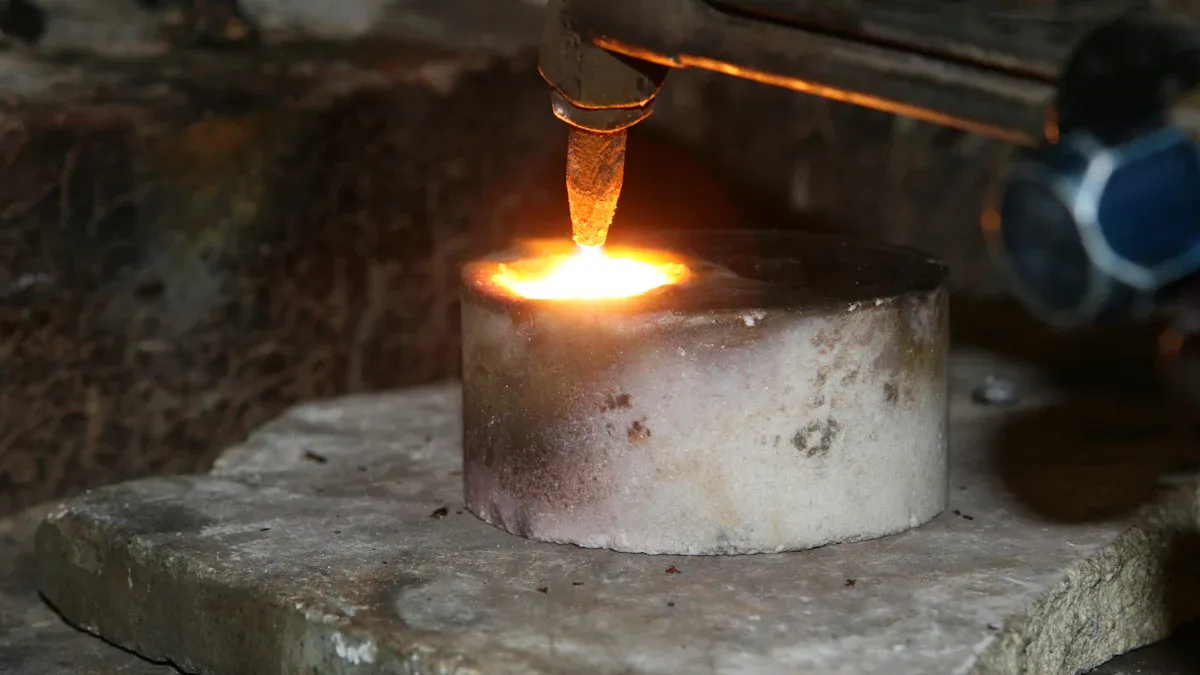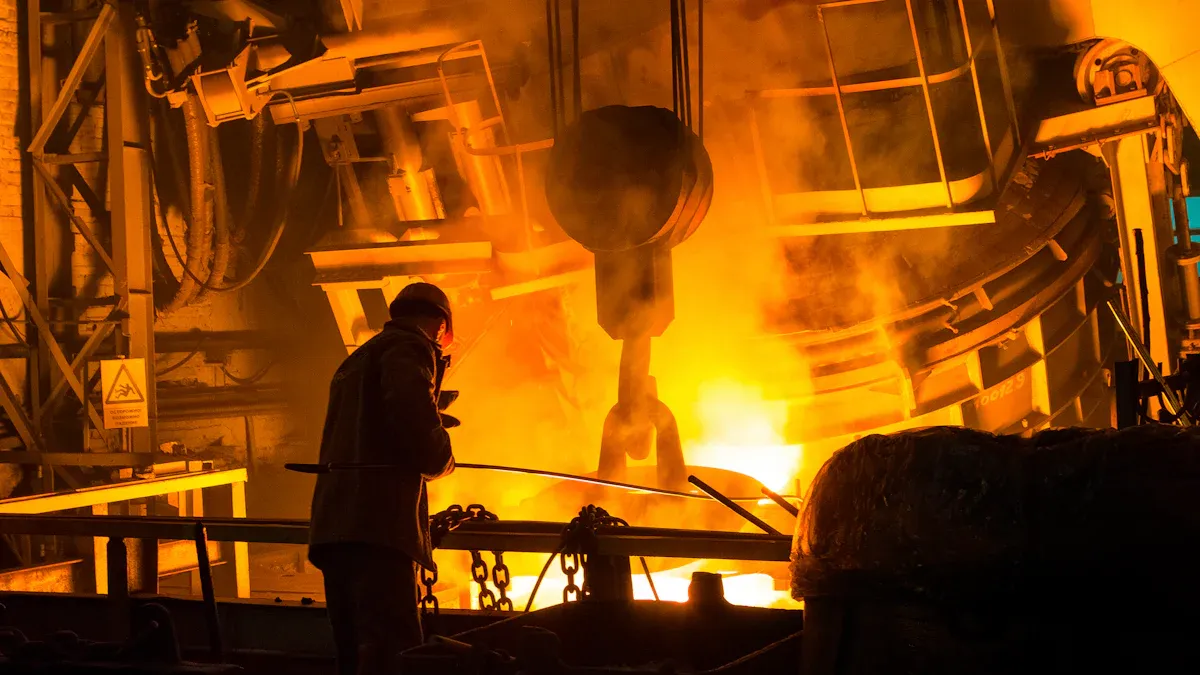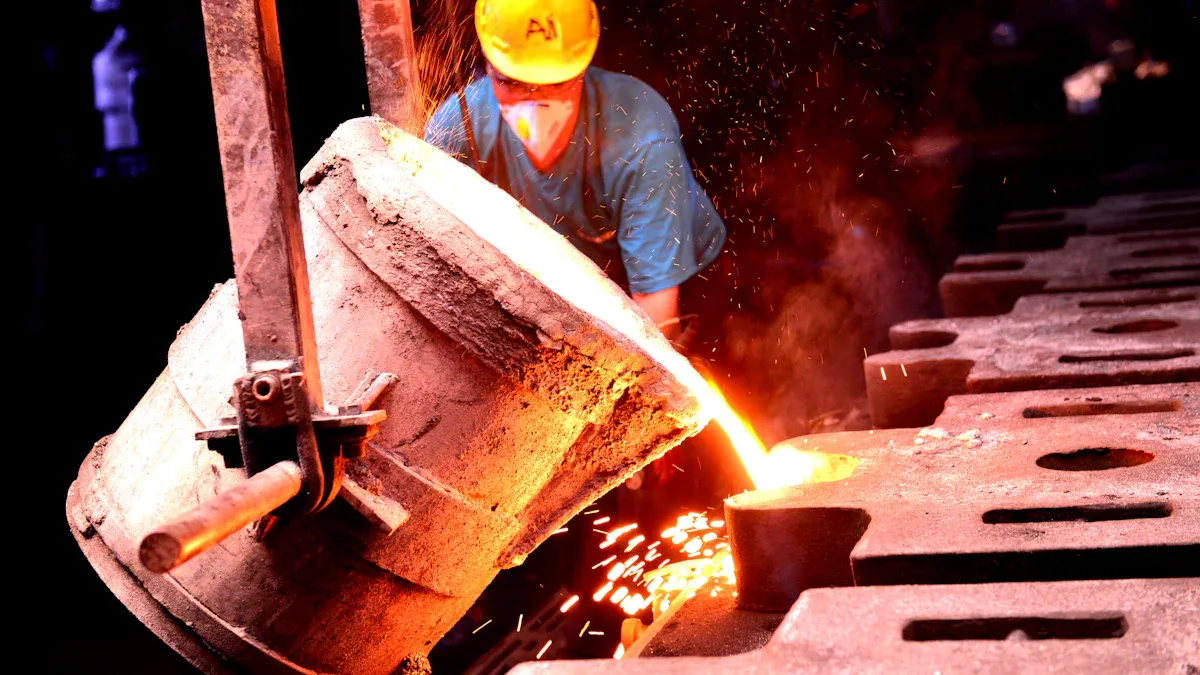Exploring the Basics of Die-Cast Aluminum Alloy

Die-cast aluminum alloy revolutionizes manufacturing by creating strong yet lightweight products. You see it used in industries needing durable components, from automotive to electronics. Its versatility allows precise shaping for complex designs. The aluminum alloy for die casting excels in corrosion resistance, making it ideal for long-lasting applications. With Aluminum Die Casting Services, manufacturers can ensure efficiency in mass production, helping them meet demand. As a leading Aluminum Die Casting Manufacturer, we provide high-quality solutions tailored to various industry needs.
Key Takeaways
- Die-cast aluminum alloy is light, strong, and resists rust. It is great for cars and airplanes.
- The die-casting method shapes detailed designs perfectly. This helps make high-quality parts in large amounts.
- Picking the right aluminum alloy is important. A380 works for most uses, while A360 is better for tough conditions.
Understanding the Die-Casting Process

What is die casting?
Die casting is a manufacturing process that shapes molten metal into specific forms using high pressure. You can think of it as pouring liquid metal into a mold to create solid, detailed parts. This method is widely used because it produces components with excellent precision and smooth surfaces. Manufacturers often rely on die casting to create parts that are both strong and lightweight.
The process works best with metals like aluminum, zinc, and magnesium. Among these, aluminum stands out for its versatility and durability. Die-cast aluminum alloy, in particular, is a popular choice due to its ability to meet the demands of various industries.
How the die-casting process works
The die-casting process involves several key steps:
- Preparing the mold: A steel mold, also called a die, is designed to match the shape of the desired part. This mold consists of two halves that fit together.
- Melting the metal: Aluminum or another metal is heated until it becomes liquid.
- Injecting the metal: The molten metal is injected into the mold under high pressure. This pressure ensures the metal fills every corner of the mold, capturing fine details.
- Cooling and solidifying: The metal cools and hardens inside the mold.
- Ejecting the part: Once solidified, the mold opens, and the finished part is removed.
This process is fast and efficient, making it ideal for mass production. It also allows you to create complex shapes that would be difficult to achieve with other methods.
Common aluminum alloys used in die casting (e.g., A380, A360, 443)
Not all aluminum alloys are the same. Some are better suited for die casting than others. Here are three commonly used alloys:
- A380: This is one of the most popular choices for die-cast aluminum alloy. It offers a great balance of strength, corrosion resistance, and thermal conductivity. You’ll often find it in automotive parts and electronic housings.
- A360: This alloy provides excellent corrosion resistance and strength. It’s ideal for parts exposed to harsh environments, such as marine equipment.
- 443: Known for its superior ductility, this alloy is perfect for applications requiring flexibility and durability.
Each alloy has unique properties, so manufacturers select the one that best fits the specific needs of a project. By choosing the right die-cast aluminum alloy, you can ensure the final product meets performance and quality standards.
Advantages of Die-Cast Aluminum Alloys
Lightweight yet strong properties
One of the most remarkable features of die-cast aluminum alloy is its ability to combine lightweight characteristics with impressive strength. This makes it an ideal choice for industries where reducing weight is crucial, such as automotive and aerospace. Aluminum alloys weigh significantly less than other metals like steel, yet they maintain the structural integrity needed for demanding applications.
For example, in the automotive industry, using lightweight materials helps improve fuel efficiency and reduce emissions. You can also find these alloys in products like bicycles and portable electronic devices, where strength and weight balance are essential.
Tip: If you’re designing a product that needs to be both durable and easy to handle, die-cast aluminum alloy offers the perfect solution.
Corrosion resistance and durability
Die-cast aluminum alloy stands out for its excellent resistance to corrosion. This property ensures that components made from it can withstand harsh environments without degrading over time. Unlike other metals that may rust or weaken, aluminum forms a natural oxide layer on its surface, protecting it from moisture and chemicals.
This durability makes it a popular choice for outdoor applications, such as marine equipment and construction materials. You’ll also see it used in consumer electronics, where long-lasting performance is a priority. By choosing die-cast aluminum alloy, you ensure your products remain reliable even in challenging conditions.
Cost-effectiveness and efficiency in mass production
Die-cast aluminum alloy offers significant cost advantages, especially when producing large quantities of parts. The die-casting process itself is highly efficient, allowing manufacturers to create complex shapes with minimal waste. Once the mold is prepared, the process can produce thousands of identical components quickly and consistently.
Additionally, aluminum is more affordable compared to other metals like titanium or copper. Its recyclability further reduces costs, as scrap aluminum can be melted down and reused without losing its quality. This makes die-cast aluminum alloy an eco-friendly and budget-friendly option for mass production.
Note: If you’re looking to optimize production costs while maintaining high-quality standards, die-cast aluminum alloy is an excellent choice.
Applications of Die-Cast Aluminum Alloys

Automotive industry
Die-cast aluminum alloy plays a vital role in the automotive industry. You’ll find it in engine blocks, transmission cases, and structural components. Its lightweight nature helps reduce vehicle weight, improving fuel efficiency and lowering emissions. The strength of aluminum alloys ensures durability, even under high stress. Manufacturers also use these alloys to create intricate designs for parts like brackets and housings, enhancing performance without adding bulk.
Aerospace and aviation
In aerospace and aviation, reducing weight is critical. Die-cast aluminum alloy meets this need by offering a combination of lightness and strength. You’ll see it used in aircraft components such as fuselage parts, brackets, and landing gear housings. Its corrosion resistance ensures reliability in extreme conditions, including high altitudes and varying temperatures. By using aluminum alloys, engineers can design parts that withstand rigorous demands while keeping aircraft efficient and safe.
Consumer electronics and appliances
Die-cast aluminum alloy is a favorite in consumer electronics and appliances. It’s used in products like smartphones, laptops, and kitchen appliances. The alloy’s ability to form precise shapes allows manufacturers to create sleek, compact designs. Its durability ensures long-lasting performance, even with daily use. You’ll appreciate how aluminum alloys contribute to lightweight devices that are easy to handle and transport.
Medical devices and renewable energy sectors
Medical devices benefit from the precision and reliability of die-cast aluminum alloy. You’ll find it in equipment like imaging machines and surgical tools. Its corrosion resistance ensures hygiene and longevity, making it ideal for healthcare applications. In renewable energy, aluminum alloys are used in solar panel frames and wind turbine components. Their lightweight and durable properties help optimize energy efficiency and reduce maintenance costs.
Comparing Die Casting to Alternative Methods
Die casting vs. sand casting
When comparing die casting to sand casting, you’ll notice key differences in precision and efficiency. Die casting uses metal molds, while sand casting relies on sand molds. Metal molds in die casting allow for smoother surfaces and more intricate details. Sand casting, on the other hand, is better suited for larger parts with simpler designs.
Die casting works well for high-volume production. The reusable molds make it faster and more cost-effective for mass production. Sand casting, however, is slower because each mold is single-use. If you need detailed, lightweight parts, die casting is the better choice. For larger, less complex components, sand casting may be more practical.
Tip: Choose die casting for precision and speed. Opt for sand casting when working with oversized parts or small production runs.
Die casting vs. investment casting
Investment casting and die casting both create detailed parts, but they differ in materials and processes. Investment casting uses wax patterns and ceramic molds, while die casting relies on metal molds. Investment casting can handle a wider range of metals, including steel and titanium. Die casting focuses on metals like aluminum, zinc, and magnesium.
Die casting is faster and more economical for large quantities. Investment casting takes longer but offers exceptional detail and material flexibility. If you prioritize speed and cost, die casting is ideal. For complex designs or exotic materials, investment casting is the way to go.
Advantages and limitations of die casting
Die casting offers many advantages. It produces parts with excellent precision, smooth surfaces, and consistent quality. The process is fast, making it perfect for mass production. Aluminum alloys used in die casting are lightweight, strong, and corrosion-resistant.
However, die casting has limitations. The initial cost of creating molds is high. It’s also less suitable for very large parts or low-volume production. Understanding these factors helps you decide if die casting fits your project’s needs.
Note: Die casting shines in high-volume production but may not suit every project. Evaluate your requirements carefully.
Die-cast aluminum alloy offers lightweight strength, corrosion resistance, and cost efficiency. You’ve seen its applications in industries like automotive, aerospace, and electronics. Its importance continues to grow as manufacturers seek durable and versatile materials. Future advancements in die-casting technology promise even greater precision and sustainability, shaping the next generation of manufacturing.
FAQ
What makes die-cast aluminum alloy better than other materials?
Die-cast aluminum alloy combines lightweight strength, corrosion resistance, and cost efficiency. It’s ideal for industries needing durable, precise, and mass-produced components.
Can die-cast aluminum parts be recycled?
Yes, aluminum is 100% recyclable. Recycling reduces waste and production costs while maintaining the material’s quality, making it an eco-friendly choice for manufacturers.
How do you choose the right aluminum alloy for die casting?
Consider your project’s needs. For example:
- A380: General use, strong and corrosion-resistant.
- A360: Harsh environments.
- 443: Flexible and durable applications.
Tip: Consult with your manufacturer to select the best alloy for your specific application.